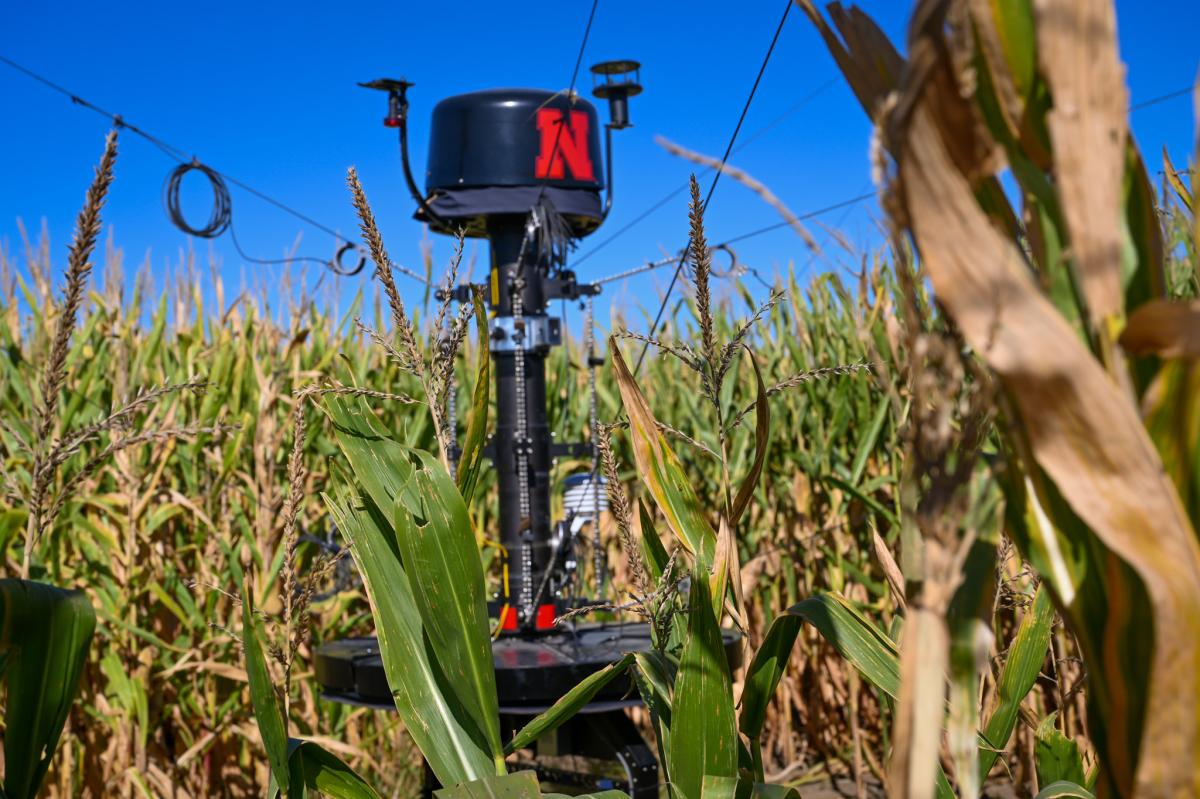
The Spidercam Gives Spider’s Eye View
Nebraska’s One-of-a-Kind Device Assists in Plant Research
The Spidercam -- a novel floating camera set collects advanced images to better understand how different types of crops breed.
The first of its kind in the United States, the Spidercam gathers more in-depth data for researchers at the Eastern Nebraska Research Extension and Education Center (ENREEC) in Mead, Nebraska.
Geng (Frank) Bai, Research Assistant Professor, and Yufeng Ge, Associate Professor both in the Department of Biological Systems Engineering at the University of Nebraska–Lincoln, manage the Spidercam core facility to better understand plants by proximal remote sensing.
“The Spidercam is an automatic phenotyping tool used for crop breeding to quantify how plants handle (a)biotic stress at a high spatiotemporal resolution,” Bai said.
The goal of breeding is to increase the crop yield, improve its resistance to insects or pests, or even speed up the maturity of the plant, which ultimately benefits all consumers.
Advantages of the Spidercam
The Spidercam can do a large amount of work automatically with better accuracy, compared with the traditional, labor-intensive methods.
“Instead of sending a large group of people to the field, our Spidercam system measures the plant traits accurately from a distance,” Bai said.
This research assists with growing the knowledge on many disciplines, including plant breeding, genetics, engineering, remote sensing, and data science. Ge said.
This information allows deeper understanding on how crops produce higher yield with better quality yet doing so with more effective usage of sources such as water and nitrogen.
“The Spidercam removes the need for growers to drive tractor or control sensors – instead, it is all automatic,” Ge said.
The Spidercam allows Bai and Ge to see what works during growing as they are happening. Gathering this precise information allows for the most accurate decisions to be made in real time. Although the Spidercam does not run continuously, it does spend a fair amount of time in the air.
A Unique Camera System
The set-up of the Spidercam is intricate, and it takes time and patience. Everything that is located at the ENREEC site has purpose and accounts for how the Spidercam efficiently runs.
For example, the type of wire the Spidercam sits on is specific to its function and the location of the elevated control system is precise to the needs of the collected data. Each part of the device is intentionally developed to maximize effectiveness, Bai said.
The Spidercam is connected to durable cable suspension system held up by poles on each corner of the field, which allows it to reach every corner of the plot site, like what one would see on a football field, Ge said. Because of this design, the Spidercam can capture a picture of every plant, mainly from the top and occasionally from the side of the plants in the test field.
The sensors on the Spidercam contain visible, hyperspectral, and thermal infrared cameras. High-resolution images are needed to do study on crop improvement and the level and type of stress the plants endure. The sensors can also detect when a plant is under stress allowing for preventative measures to be taken.
Overlooking the field at ENREEC, a two-story building holds the electronic control system for the Spidercam. One can manually move the Spidercam, if needed. A subsurface drip irrigation system is incorporated within the field, which helps control and monitor the different amounts of water the crops receive.
“One of the challenges with field research is really the variability of the environment,” Ge said. “For precise control of the soil moisture content of a plot of land, the subsurface drip irrigation system is used.”
David Scoby, Laboratory Research Manager, manages the research field. Scoby plants and harvests crops, applies nutrients and chemicals, manages the drip irrigation system, and assists Bai with mounting the Spidercam dolly.
“There are 128 plots including different kinds of crops and different kinds of hybrids – everything has to be planned out ahead of time,” Scoby said.
The Future of Spidercam
The information Spidercam collects will change how farmers make decisions about what to plant, what inputs to use, and how to manage their crop. While there currently is not room for the Spidercam technology to be replicated on every field in Nebraska, the information collected will gather data that will be useful for all Nebraska farmers in the future.
“There are farmers and extension educators coming to us and seeing the kind of research and information we generated and transferring it into application for farmers,” said Bai
Both Bai and Ge see the Spidercam growing over the years by hopefully having more than one and having it cover larger fields.
“The goal is for the Spidercam to be able to connect with some of those more advanced breeding and molecular techniques like genome editing, digital twin in plants,” Ge said.
For more information regarding Spidercam, please visit https://ard.unl.edu/phenotyping/field-phenotyping-facility
Key Takeaways
- The Spidercam is a one-of-a-kind floating camera system that captures in-depth photos of plants to measure growth and detect stresses.
- The first of its kind in the United States, the Spidercam gathers in-depth data for researchers at the Eastern Nebraska Research Extension and Education Center (ENREEC) in Mead, Nebraska, with full automation.
- The Spidercam is connected to durable cable suspension system held up by poles on each corner of the field, which allows it to reach location capturing a picture of every plant in the test field.
- Data from the Spidercam accelerates the improvement of crops for higher yield, better quality, and more efficient use of resources, and eventually have a big impact on growers’ economy.
- For more information regarding Spidercam, please visit https://ard.unl.edu/phenotyping/field-phenotyping-facility
